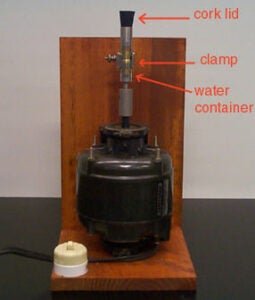T.2(1) – Vapor Pressure
This apparatus consists of a motor with a rotating shaft and a small metallic tube coupled to it. There is a little water inside the tube and a cork as a lid. Hold the tube with a clamp — small pieces of felt cover each claw. Turn on the motor. As the motor runs, heat is produced by friction between the rotating shaft and the stationary clamp. The heat produced boils and vaporizes the water, building up enough pressure to pop the cork after 2-3 minutes.

T.2(2) – Mechanical Equivalent of Heat Apparatus
Mechanical Equivalent of Heat apparatus allows accurate determination of the Mechanical Equivalent of Heat (to within 5%). A measurable amount of work is performed by turning the crank, which turns the aluminum cylinder. A nylon rope is wrapped several times around the cylinder so that, as the crank is turned, the friction between the rope and the cylinder is just enough to support a mass hanging from the other end of the rope. This insures that the torque acting on the cylinder is constant and measurable. A counter keeps track of the number of turns.
As the cylinder turns, the friction between the cylinder and the rope converts the work into thermal energy, which raises the temperature of the aluminum cylinder. Measuring the resistance of the thermistor, which is embedded in the aluminum, the temperature of the cylinder can be determined. The ratio between the work performed and the thermal energy transferred into the cylinder determines, J, the mechanical equivalent of heat.